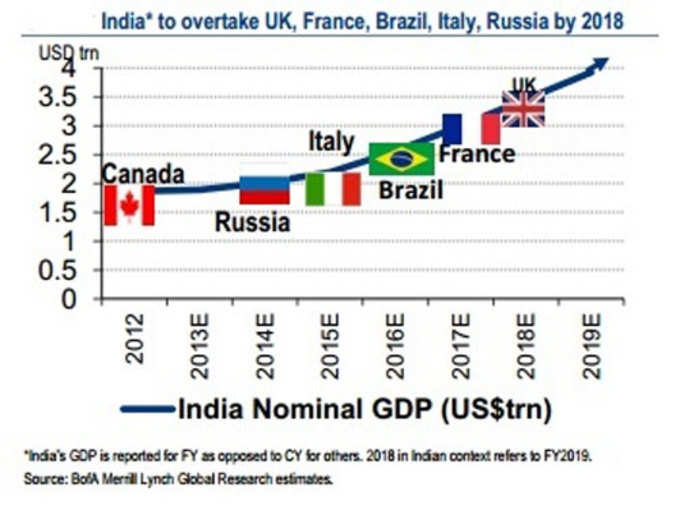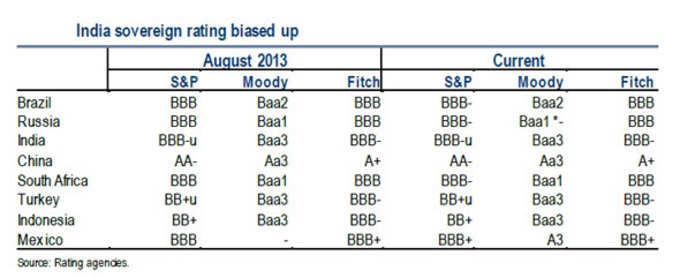“We expect rating agencies to upgrade their outlook for India sooner rather than later,” BofA-ML said in a report authored by Indranil Sen Gupta and Abhishek Gupta.
“We also thought the April 2012 S&P outlook downgrade was unwarranted. With Moody’s downgrading their Brazil outlook last night, key EM peers are seeing downgrades,” added the report.
Last week India pitched for a rating upgrade by international credit agency Moody’s, citing steps unveiled in the Budget 2014-15 to keep the fiscal deficit in check and provide impetus to growth.
Moody’s has assigned ‘Baa3’ rating to India, with a stable outlook, which suggests possibility of an upgrade. According to Moody’s, “the rating reflects high domestic savings and adequate
BofA-ML has identified top 5 compelling reasons for an outlook upgrade for India:
Growth bottoming out: 5.5% FY15, 6.5% FY16, 7.5% FY18
The slowdown in growth has largely been driven by the global down cycle rather than domestic structural issues. In fact, growth is bottoming out far higher than Brazil or Russia. This is why we always found concern that India would fall out of BRICs in 2012 to be baseless. In fact, BofA-ML believes that India should emerge as the second-largest EM after China by 2019.
The global investment bank continues to reiterate its standing view that India’s potential growth is about 7.5%. It says, “We never thought that potential growth should be raised to 8-9% just because an upcycle pushed growth up to 8.4% during 2004-08.”
 |
BofA-ML also believes that inflation is largely ‘imported’ rather than being home-grown for all the lament about India’s ‘inflation problem’. “As we have often highlighted, the RBI’s growth-inflation trade-off has been far better than most EM peers,” it says.
In any case, the global investment bank thinks that inflation is peaking. “Although we have higher-than consensus inflation forecasts (8.5% in August, 7.8% consensus; 8% in July, 7.4% consensus, 8% actual), this is driven by a temporary spike in tomato prices on poor rains. This will reverse with the seasonal rainfall deficit down to 11 per cent of normal,” it says.
Risks from twin deficits have proved overdone.
At the same time, this will likely not impact the government’s Rs4958bn net borrowing, as it has also inherited a large cash surplus of Rs1284bn with the RBI from the previous
 |
RBI to buy FX to guard against contagion; hold Rs58-62/USD
BofA-ML continues to expect Governor
As import cover plummeted, that led to a 50% depreciation later. This will likely stabilize Rs58-62/USD. “Any emerging market today is going to look at the currency volatility and say ‘whatever money comes in, I’m going to be careful about it, I am going to build some reserves’..,” Governor Rajan reiterated last week.
RBI to cut rates even if Fed hikes; 75 bps cut February onwards
BofA-ML believes that the RBI can cut rates even if the Fed hikes rates from September 2015, with Governor Rajan recouping FX reserves. “We see it cutting policy rates by 75-100bp starting in February, even if Fed Chair Janet Yellen hikes from September 2015, as our US economists expect,” it says.